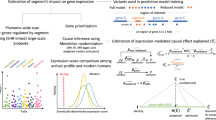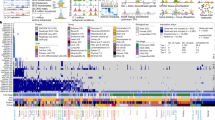Abstract
Retroviral insertional mutagenesis in BXH2 and AKXD recombinant inbred mice induces a high incidence of myeloid or B- and T-cell leukaemia1,2 and the proviral integration sites in the leukaemias provide powerful genetic tags for disease gene identification. Some of the disease genes identified by proviral tagging are also associated with human disease3,4,5, validating this approach for human disease gene identification. Although many leukaemia disease genes have been identified over the years, many more remain to be cloned6. Here we describe an inverse PCR (IPCR) method for proviral tagging that makes use of automated DNA sequencing and the genetic tools provided by the Mouse Genome Project, which increases the throughput for disease gene identification. We also use this IPCR method to clone and analyse more than 400 proviral integration sites from AKXD and BXH2 leukaemias and, in the process, identify more than 90 candidate disease genes. Some of these genes function in pathways already implicated in leukaemia, whereas others are likely to define new disease pathways. Our studies underscore the power of the mouse as a tool for gene discovery and functional genomics.
This is a preview of subscription content, access via your institution
Access options
Subscribe to this journal
Receive 12 print issues and online access
$209.00 per year
only $17.42 per issue
Buy this article
- Purchase on Springer Link
- Instant access to full article PDF
Prices may be subject to local taxes which are calculated during checkout

Similar content being viewed by others
References
Bedigian, H.G., Johnson, D.A., Jenkins, N.A., Copeland, N.G. & Evans, R. Spontaneous and induced leukemias of myeloid origin in recombinant inbred BXH mice. J. Virol. 51, 586–594 (1984).
Gilbert, D.J., Neumann, P.E., Taylor, B.A., Jenkins, N.A. & Copeland, N.G. Susceptibility of AKXD recombinant inbred mouse strains to lymphomas. J. Virol. 67, 2083–2090 (1993).
Ogawa, S. et al. Structurally altered Evi-1 protein generated in the 3q21q26 syndrome. Oncogene 13, 183–191 (1996).
Copeland, N.G. & Jenkins, N.A. Myeloid leukemia: disease genes and mouse models. in Animal Models of Cancer Predisposition Syndromes (eds Hiai, H. & Hino, O.) 53–63 (Karger, Basel, 1999).
Roberts, T., Chernova, O. & Cowell, J.K. NB4S, a member of the TBC1 domain family of genes, is truncated as a result of a constitutional t(1;10)(p22;q21) chromosome translocation in a patient with stage 4S neuroblastoma. Hum. Mol. Genet. 7, 1169–1178 (1998).
Look, A.T. Oncogenic transcription factors in the human acute leukemias. Science 278, 1059–1064 (1997).
Silver, J. & Keerikatte, V. Novel use of polymerase chain reaction to amplify cellular DNA adjacent to an integrated provirus. J. Virol. 63, 1924–1928 (1989).
Sorensen, A.B., Duch, M., Jorgensen, P. & Pedersen, F.S. Amplification and sequence analysis of DNA flanking integrated proviruses by a simple two-step polymerase chain reaction method. J. Virol. 67, 7118–7124 (1993).
Valk, P.J.M., Joosten, M., Vankan, Y., Lowenberg, B. & Delwel, R. A rapid RT-PCR based method to isolate complementary DNA fragments flanking retrovirus integration sites. Nucleic Acids Res. 25, 4419–4421 (1997).
Nakamura, T., Largaespada, D.A., Shaughnessy, J.D. Jr, Jenkins, N.A. & Copeland, N.G. Cooperative activation of Hoxa and Pbx1-related genes in murine myeloid leukaemias. Nature Genet. 12, 149–153 (1996).
Shannon, K. The Ras signaling pathway and the molecular basis of myeloid leukemogenesis. Curr. Opin. Hematol. 2, 305–308 (1995).
Kawasaki, H. et al. A Rap guanine nucleotide exchange factor enriched highly in the basal ganglia. Proc. Natl Acad. Sci. USA 95, 13278–13283 (1998).
Ebinu, J.O. et al. RasGRP, a Ras guanyl nucleotide-releasing protein with calcium- and diacylglycerol-binding motifs. Science 280, 1082–1086 (1998).
van de Wetering, M., Oosterwegel, M., van Norren, K. & Clevers, H. Sox-4, an Sry-like HMG box protein, is a transcriptional activator in lymphocytes. EMBO J. 12, 3847–3854 (1993).
Jonkers, J. & Berns, A. Retroviral insertional mutagenesis as a strategy to identify cancer genes. Biochim. Biophys. Acta 1287, 29–57 (1996).
Carballo, E., Lai, W.S. & Blackshear, P.J. Feedback inhibition of macrophage tumor necrosis factor-α production by tristetraprolin. Science 281, 1001–1005 (1998).
Taylor, G.A. et al. A pathogenetic role for TNF α in the syndrome of cachexia, arthritis, and autoimmunity resulting from tristetraprolin (TTP) deficiency. Immunity 4, 445–454 (1996).
Copeland, N.G. & Jenkins, N.A. Development and applications of a molecular genetic linkage map of the mouse genome. Trends Genet. 7, 113–118 (1991).
Ward, Y. et al. Control of MAP kinase activation by the mitogen-induced threonine/tyrosine phosphatase PAC1. Nature 367, 651–654 (1994).
Pear, W.S. et al. Exclusive development of T cell neoplasms in mice transplanted with bone marrow expressing activated Notch alleles. J. Exp. Med. 183, 2283–2291 (1996).
Rohn, J.L., Lauring, A.S., Linenberger, M.L. & Overbaugh, J. Transduction of Notch2 in feline leukemia virus-induced thymic lymphoma. J. Virol. 70, 8071–8080 (1996).
Ellisen, L.W. et al. TAN-1, the human homolog of the Drosophila notch gene, is broken by chromosomal translocations in T lymphoblastic neoplasms. Cell 66, 649–661 (1991).
Vitols, S., Gahrton, G., Bjorkholm, M. & Peterson, C. Hypocholesterolaemia in malignancy due to elevated low-density lipoprotein-receptor activity in tumour cells: evidence from studies in patients with leukaemia. Lancet 2, 1150–1154 (1985).
Cable, S. et al. Peroxisomes in human colon carcinomas. A cytochemical and biochemical study. Virchows Arch. B Cell Pathol. Incl. Mol. Pathol. 62, 221–226 (1992).
Ericsson, J., Usheva, A. & Edwards, P.A. YY1 is a negative regulator of transcription of three sterol regulatory element-binding protein-responsive genes. J. Biol. Chem. 274, 14508–14513 (1999).
Austen, M., Cerni, C., Luscher-Firzlaff, J.M. & Luscher, B. YY1 can inhibit c-Myc function through a mechanism requiring DNA binding of YY1 but neither its transactivation domain nor direct interaction with c-Myc. Oncogene 17, 511–520 (1998).
Jenkins, N.A., Copeland, N.G., Taylor, B.A., Bedigian, H.G. & Lee, B.K. Ecotropic murine leukemia virus DNA content of normal and lymphomatous tissues of BXH-2 recombinant inbred mice. J. Virol. 42, 379–388 (1982).
Feinberg, A.P. & Vogelstein, B. A technique for radiolabeling DNA restriction endonuclease fragments to high specific activity. Anal. Biochem. 132, 6–13 (1983).
Mucenski, M.L., Taylor, B.A., Jenkins, N.A. & Copeland, N.G. AKXD recombinant inbred strains: models for studying the molecular genetic basis of murine lymphomas. Mol. Cell. Biol. 6, 4236–4243 (1986).
Luo, G., Ivics, Z., Izsvak, Z. & Bradley, A. Chromosomal transposition of a Tc1/mariner-like element in mouse embryonic stem cells. Proc. Natl Acad. Sci. USA 95, 10769–10773 (1998).
Acknowledgements
We thank N. O'Sullivan for technical assistance; D. Gilbert for help with the IB mapping; and H.C. Morse and M.C. Dean for helpful comments. This research was sponsored in part by the National Cancer Institute, DHHS, under contract with ABL.
Author information
Authors and Affiliations
Corresponding author
Rights and permissions
About this article
Cite this article
Li, J., Shen, H., Himmel, K. et al. Leukaemia disease genes: large-scale cloning and pathway predictions. Nat Genet 23, 348–353 (1999). https://doi.org/10.1038/15531
Received:
Accepted:
Issue Date:
DOI: https://doi.org/10.1038/15531
This article is cited by
-
Murine leukemia virus (MLV) P50 protein induces cell transformation via transcriptional regulatory function
Retrovirology (2023)
-
Zfp296 knockout enhances chromatin accessibility and induces a unique state of pluripotency in embryonic stem cells
Communications Biology (2023)
-
ASXL1 mutations with serum EPO levels predict poor response to darbepoetin alfa in lower-risk MDS: W-JHS MDS01 trial
International Journal of Hematology (2022)
-
The basic helix-loop-helix transcription factor SHARP1 is an oncogenic driver in MLL-AF6 acute myelogenous leukemia
Nature Communications (2018)
-
Zfp296 negatively regulates H3K9 methylation in embryonic development as a component of heterochromatin
Scientific Reports (2017)



